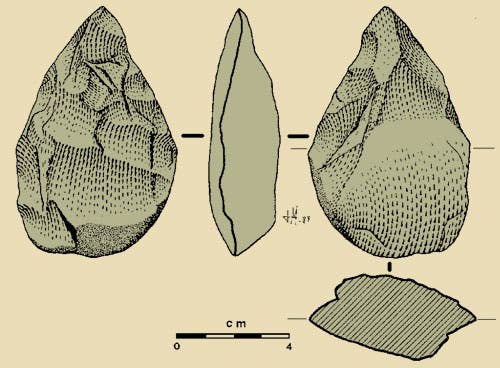While searching for the remains of an ancient human ancestor, archaeologists came across a lot more than their bargained for: the oldest stone tools ever found so far. The archaic stones they found were clearly deliberately manipulated by hominid hands, and not the result of some natural formation. According to paleomagnetic dating techniques, the artifacts are about 3.3 million years old, or 700,000 years older than previous artifacts.

Before these tools were discovered near Lake Turkana, Kenya, the oldest stone tools were 2.6 million years old, classed as Oldowan technology. Homo habilis, an ancestor of Homo sapiens, was the first hominid to manufacture Oldowan tools. To make an Oldowan cutting tool, you need to hit a stone “core” with a stone “hammer” in such a way that a flake sharp enough to butcher an animal is struck off. Very similar to Oldowan, the archaeologists called this newly surfaced ancient manufacturing method the Lomekwi technology. A total of 20 stone flakes and anvils were found, and are said to predate Homo humans by 500,000 years. Interestingly enough, the tools were found both at the surface and underneath. Actually, the team led by Sonia Harmand, an archeologist at Stony Brook University in New York, came about the milestone discovery completely by accident while scouring the vicinity for remains of an ancient human relative, Kenyanthripos platyops, when they took a wrong turn and ended up at a different site known as Lomekwi 3.
The tools are larger than Oldowan. This might have been a ‘thing’, since the early ancestors used big, heavy blocks of very hard raw material from nearby sources even though smaller blocks were available.
“The cores and flakes we recovered are clearly knapped and are not the result of accidental or natural rock fracture,” Harmand said. “The Lomekwi 3 knappers were able to deliver sufficient intentional force to detach repeatedly series of adjacent and superposed flakes and then to continue knapping by rotating the cores.”
Until now, it was believed that the creation of stone tools started with Homo. The findings suggest, however, that the flakes were made by ancient human precursors known as australopithecines. The famous skeleton of “Lucy” is a prime example of such hominids.
Findings were presented at the annual meeting of the Paleoanthropology Society in San Francisco.


